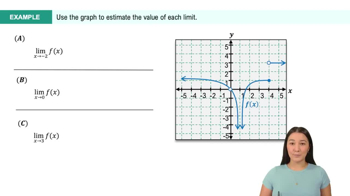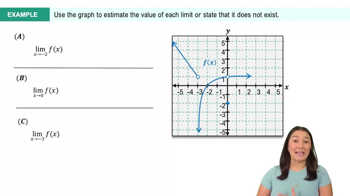Table of contents
- 0. Functions7h 52m
- Introduction to Functions16m
- Piecewise Functions10m
- Properties of Functions9m
- Common Functions1h 8m
- Transformations5m
- Combining Functions27m
- Exponent rules32m
- Exponential Functions28m
- Logarithmic Functions24m
- Properties of Logarithms34m
- Exponential & Logarithmic Equations35m
- Introduction to Trigonometric Functions38m
- Graphs of Trigonometric Functions44m
- Trigonometric Identities47m
- Inverse Trigonometric Functions48m
- 1. Limits and Continuity2h 2m
- 2. Intro to Derivatives1h 33m
- 3. Techniques of Differentiation3h 18m
- 4. Applications of Derivatives2h 38m
- 5. Graphical Applications of Derivatives6h 2m
- 6. Derivatives of Inverse, Exponential, & Logarithmic Functions2h 37m
- 7. Antiderivatives & Indefinite Integrals1h 26m
1. Limits and Continuity
Introduction to Limits
Problem 14b
Textbook Question
Let g(x)=8∣x−2∣x3−4x. <IMAGE>
Make a conjecture about the values of x→2−limg(x), x→2+limg(x), and x→2limg(x) or state that they do not exist.
 Verified step by step guidance
Verified step by step guidance1
First, understand that the function g(x) = \frac{x^3 - 4x}{8|x-2|} is defined piecewise due to the absolute value in the denominator. This means we need to consider the behavior of the function as x approaches 2 from the left (x -> 2^-) and from the right (x -> 2^+).
To find \lim_{x \to 2^-} g(x), consider x approaching 2 from the left. In this case, |x-2| = -(x-2) because x < 2. Substitute this into the function to get g(x) = \frac{x^3 - 4x}{8(-(x-2))}. Simplify the expression and evaluate the limit as x approaches 2 from the left.
Next, find \lim_{x \to 2^+} g(x) by considering x approaching 2 from the right. Here, |x-2| = x-2 because x > 2. Substitute this into the function to get g(x) = \frac{x^3 - 4x}{8(x-2)}. Simplify the expression and evaluate the limit as x approaches 2 from the right.
Compare the results of \lim_{x \to 2^-} g(x) and \lim_{x \to 2^+} g(x). If these two one-sided limits are equal, then \lim_{x \to 2} g(x) exists and is equal to this common value. If they are not equal, then \lim_{x \to 2} g(x) does not exist.
Finally, state your conjecture based on the calculations: whether the limits \lim_{x \to 2^-} g(x), \lim_{x \to 2^+} g(x), and \lim_{x \to 2} g(x) exist or not, and if they exist, what their values are.
Recommended similar problem, with video answer:
 Verified Solution
Verified SolutionThis video solution was recommended by our tutors as helpful for the problem above
Video duration:
4mPlay a video:
Was this helpful?

 6:47m
6:47mWatch next
Master Finding Limits Numerically and Graphically with a bite sized video explanation from Callie
Start learning





